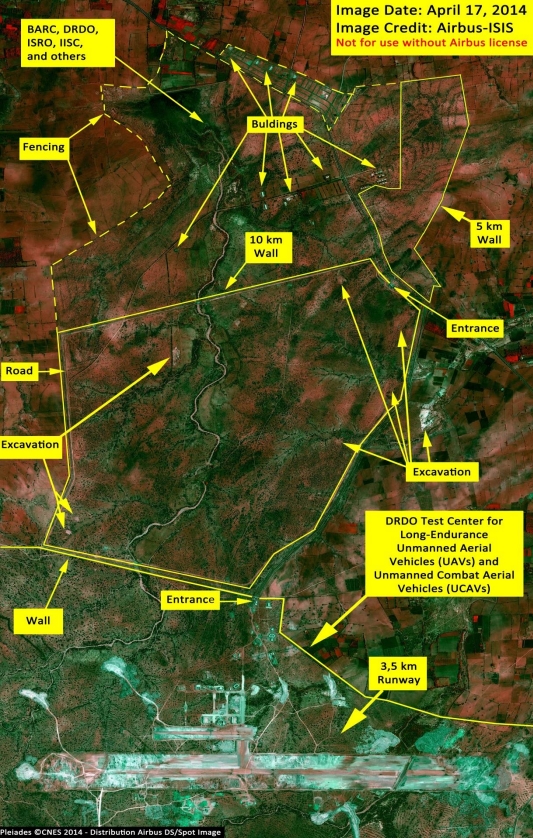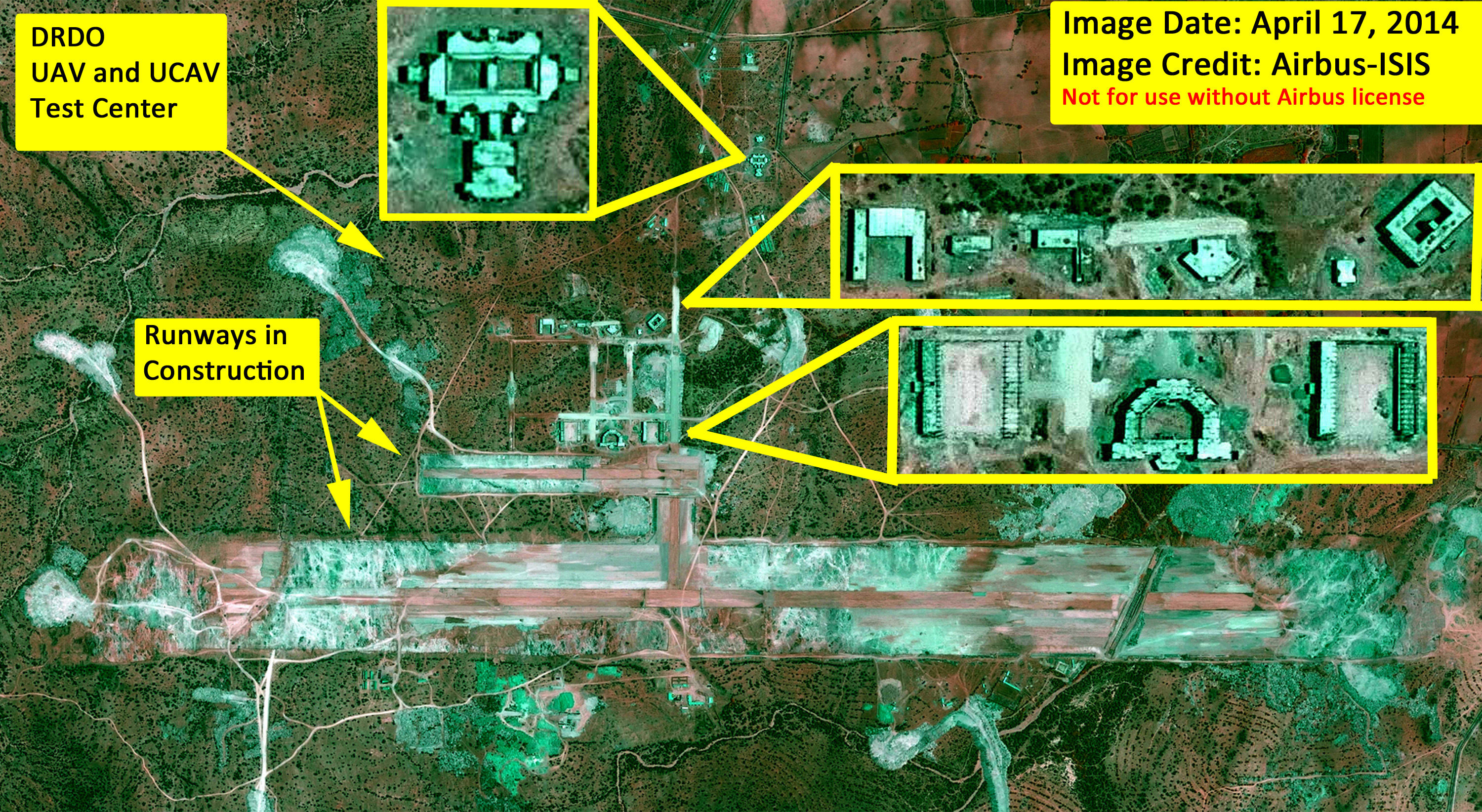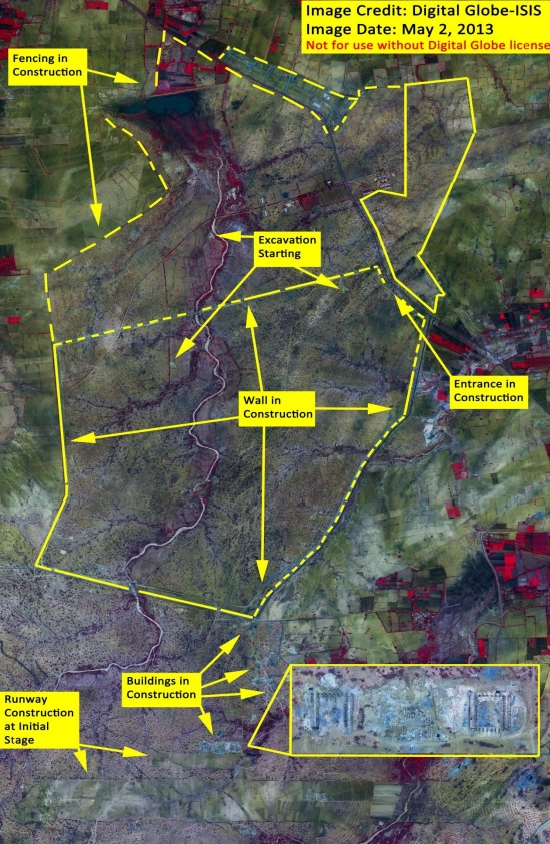Reports
India’s New Uranium Enrichment Plant in Karnataka
by David Albright and Serena Kelleher-Vergantini
July 1, 2014
India is in the early stages of building a large uranium enrichment centrifuge complex, the Special Material Enrichment Facility (SMEF), in Karnataka. This new facility will significantly increase India’s ability to produce enriched uranium for both civil and military purposes, including nuclear weapons. India should announce that the SMEF will be subject to International Atomic Energy Agency (IAEA) safeguards, committed only to peaceful uses, and built only after ensuring it is in compliance with environmental laws in a process that fully incorporates stakeholders. Other governments and suppliers of nuclear and nuclear-related dual use goods throughout the world must be vigilant to prevent efforts by Indian trading and manufacturing companies to acquire such goods for this new enrichment facility as well as for India’s operational gas centrifuge plant, the Rare Materials Plant, near Mysore.
India has been pursuing a gas centrifuge program to enrich uranium since the 1970s.1 In 1982, the Department of Atomic Energy decided to construct a “classified technology demonstration project,” the Rare Materials Project, as a unit of the Bhabha Atomic Research Center (BARC) at Mysore for uranium enrichment.2 Over the last three decades, this project has matured and now is believed to be the home of India’s first major centrifuge plant, which is called the Rare Materials Plant (RMP). Although the RMP was not publicly revealed by the Indian government, ISIS first located this site several years ago and has since monitored the development of the RMP with commercial satellite imagery (see analysis here, here, and here). The plant is believed to have produced highly enriched uranium (HEU) for India’s indigenously developed INS Arihant nuclear-powered ballistic missile submarine and may produce HEU for nuclear weapons, including thermonuclear weapons. ISIS will return to a discussion of the estimated capacity of the centrifuges at the RMP and India’s estimated HEU stocks in a publication currently being prepared.
India’s need for highly enriched uranium is growing since it already started the construction of its second nuclear-powered submarine (INS Aridaman) and is believed to have plans to start the construction of a third and potentially a fourth one.3 Although its HEU needs for nuclear weapons are difficult to determine, India has not denied it is producing HEU for weapons at the RMP. Furthermore, India has stated that it wants to produce low enriched uranium (LEU) for power reactors, which would require a far larger capacity than the one at RMP.
Given its planned increased enriched uranium needs, India announced publicly its intention to build the Special Material Enrichment Facility, an industrial-scale centrifuge complex in Chitradurga District (Karnataka).
The Special Material Enrichment Facility (SMEF) in Chitradurga, Karnataka
Between 2009 and 2010, an area of approximately 10,000 acres in the Chirtradurga District of Karnataka was diverted for various defense, industrial, infrastructure, institutional, and commercial purposes. Within this area, 1410 acres in Ullarthi Kaval and 400 acres in Khudapura were allocated to BARC for the purpose of developing the SMEF. Additionally, 4000 acres in Varavu Kaval and 290 acres in Khudapura were allocated to India’s Defense Research and Development Organization (DRDO) for the purpose of developing an advanced research and development complex and test center for long-endurance (48-72 hours) Unmanned Aerial Vehicles (UAVs) and Unmanned Combat Aerial Vehicles (UCAVs).4
In 2011, India announced publicly its intention to build this industrial-scale centrifuge complex in Challakere Taluk, Chitradurga District (Karnataka).5 India’s top nuclear official said in 2011 that the Special Material Enrichment Facility will not be safeguarded and will have multiple roles, both civilian and military.6 BARC recently confirmed this dual-use intention and described the facility as a “large scale facility” compared to the Rare Materials Project, implying that the new site will also house gas centrifuges.7 This site could be dedicated to the production of both HEU and LEU for military and civilian purposes. India has reportedly been producing HEU for its nuclear submarine at the RMP and may also intend on producing HEU at the SMEF once it is operational.8
Citizens and environmental groups have challenged the siting in Karnataka of this BARC facility and other adjacent facilities being built by India’s Defense Research and Development Organization as illegal because of environmental concerns.9 As a result of the legal actions of the Environment Support Group (ESG), India’s National Green Tribunal, the government’s environmental oversight body, stayed all ongoing work at these sites in August 2013.10 However, given the continuation of construction, the Tribunal had to re-affirm the halting of all construction in the area.11
ISIS used publicly available information to locate the SMEF site. Recent commercial satellite imagery shows that BARC has finished some preparatory work at the site, but major construction of this larger centrifuge plant has not yet started. However, major construction appears to be taking place at the DRDO location (see below).
Imagery of the Khudapura Location
Much of the land allegedly allotted to BARC, DRDO, the Indian Institute of Science (IISc), the Indian Space Research Organization (ISRO), the Karnataka Small Scale Industries Development Corporation (KSSIDC), and the Sagitaur Ventures India Pvt. Ltd, is close to the village of Khudapura, situated in Challakere Taluk within the Chitradurga District in Karnataka.
An April 17, 2014 Airbus commercial satellite imagery (figure 1) shows how the alleged areas allotted to BARC, DRDO, IISc, ISRO, KSSIDC, and Sagitaur Ventures are being closed off with walls and other forms of fencing. Figure 1 shows two areas that have been isolated with 10 km and 5 km walls. Additionally, a 3.5 kilometer runway (as well as a secondary runway) is clearly visible south of this area. This runway is believed to be in the area dedicated to DRDO’s test center for long-endurance unmanned aerial vehicles (UAVs) and unmanned combat aerial vehicles (UCAVs)(see also figure 2).
Previous Digital Globe commercial satellite imagery shows the status of the Khudapura site on May 2, 2013 (see figure 3). In this earlier image, one wall and fencing are under construction and small excavation activity is taking place in several areas. Additionally, the DRDO runway, as well as the surrounding buildings, are clearly at the initial construction stage.
Imagery of the Ullarthi Kaval Location
Another section of land allegedly allotted to BARC, ISRO , and KSSIDC is close to the village of Ullarthi Kaval, situated in Challakere Taluk within the Chitradurga District in Karnataka. Although clear signs of construction are not yet visible, Airbus imagery from April 4, 2014 shows that pieces of land of being fenced off by what appears to be a wall. Also, as figure 4 shows, a row of five medium size and five smaller buildings are visible on the eastern perimeter of the site, as well as what appear to be possible wells.
ISIS believes that of the two sites associated with the SMEF, this one could be the main location of BARC’s new uranium enrichment facility. The reasons are twofold. First, BARC has been allotted many more acres in Ullarthi Kaval compared to Khudapura (1,410 versus 400 acres respectively). Second, it is unwise to build a nuclear enrichment facility almost adjacent to a UAV and UCAV test center. A statement from BARC could resolve this question and would be welcome.
Findings and Recommendations
Although India has recently ratified the Additional Protocol to its Safeguards Agreement,12 it does not contain any additional requirements obligating India to safeguard enrichment facilities such as the Special Material Enrichment Facility. For this reason, ISIS recommends that the Special Material Enrichment Facility should be limited to non-military uses, placed under IAEA safeguards, and built only after ensuring it is in compliance with environmental laws in a process that fully incorporates stakeholders. India has allegedly pursued illegal means to outfit the RMP and is likely to attempt to do so for this new enrichment plant. Governments and suppliers of nuclear and nuclear-related dual-use goods throughout the world should be vigilant to prevent efforts by Indian trading and manufacturing companies to acquire goods for the new centrifuge complex in Karnataka as well as continuing to remain vigilant about efforts to outfit the RMP.
As a matter of policy, the United States does not approve transfers of goods to sensitive nuclear facilities, such as Indian enrichment plants. Additionally, in 2011, the Nuclear Suppliers Group (NSG) strengthened its guidelines on nuclear enrichment and reprocessing (ENT) transfers in order to prevent any non-NPT member, e.g. India, from acquiring enrichment related technology from NSG members, irrespective of the nature of the facility (civilian or military).13 However, if BARC or other Indian nuclear entities are facilitating or allowing such imports, that casts doubt on their suitability as a recipient of U.S. and other supplier countries’ goods, regardless of the US/Indian civil nuclear cooperation agreement’s separation between Indian military and civil nuclear programs.




1 See David Albright and Susan Basu, India’s Gas Centrifuge Enrichment Program: Growing Capacity for Military Purposes, Institute for Science and International Security (ISIS), January 18, 2007, http://isis-online.org/uploads/isis-reports/documents/indiagrowingcapacity.pdf. 2 Saurav Jha, “Enrichment capacity enough to fuel nuke subs,” Saurav Jha, IBNLive Specials, Interview with Dr. Srikumar Banerjee, chairman of Atomic Energy Commission of India, November 26, 2011, http://ibnlive.in.com/news/enrichment-capacity-enough-to-fuel-nuke-subs/206066-61.html. 3 T.S. Subramanian, “In the event of a nuclear incident, victims must get prompt compensation,” The Hindu, September 6, 2010, http://www.thehindu.com/opinion/op-ed/article615818.ece “India’s Nuclear Submarine Force Shaping Up,” Defense News, May 18, 2013, http://defencenews.in/defence-news-internal.aspx?id=UkatsKbOlb4=. 4 Leo Saldanha, Forfeiting Our Commons, Environment Support Group Report, June 2013, http://www.academia.edu/3841386/ESG_Report_on_Challakeres_Amrit_Mahal_Kaval_Grasslands_Submitted_to_Expert_Committee_Appointed_by_National_Green_Tribunal. 5 The land for this facility was transferred to BARC in late 2010. 6 “Enrichment capacity enough to fuel nuke subs,” IBNLive Specials, Interview with Dr. Srikumar Banerjee, op. cit. 7 Statement of objections filed by the Respondent Nos. 10 (Bhabha Atomic Research Centre) and 12 (Defense Research and Development Organization), op. cit. In this document, the purpose of the new facility is stated to be meeting “the future requirement of upgraded fuel for use in power sector as well as other strategic purposes.” 8 Saurav Jha, “Enrichment capacity enough to fuel nuke subs,” Saurav Jha, IBNLive Specials, Interview with Dr. Srikumar Banerjee, chairman of Atomic Energy Commission of India, November 26, 2011, http://ibnlive.in.com/news/enrichment-capacity-enough-to-fuel-nuke-subs/206066-61.html; T.S. Subramanian, “In the event of a nuclear incident, victims must get prompt compensation,” The Hindu, September 6, 2010, http://www.thehindu.com/opinion/op-ed/article615818.ece. 9 Leo Saldanha, Forfeiting Our Commons, Environment Support Group Report, June 2013, http://www.academia.edu/3841386/ESG_Report_on_Challakeres_Amrit_Mahal_Kaval_Grasslands_Submitted_to_Expert_Committee_Appointed_by_National_Green_Tribunal. 10 “National Green Tribunal orders Status Quo on activities of DRDO, BARC, ISRO, IISc, et.al., in Challakere, Chitradurga.” Press Release, August 21, 2013, http://www.esgindia.org/campaigns/press/national-green-tribunal-orders-status-qu.html. 11 “National Green Tribunal halts all construction activity in Challakere Amrut Mahal Kavals,” Press Release, February 26, 2014, http://www.esgindia.org/sites/default/files/events/press/esg-press-release-ngt-stays-construction.pdf. 12 “Ahead of Modi’s US trip, IAEA pact ratified,” The Times of India, June 24, 2014, http://timesofindia.indiatimes.com/india/Ahead-of-Modis-US-trip-IAEA-pact-ratified/articleshow/37105871.cms. 13 According to Paragraph VI(a) of the NSG’s revised guidelines, suppliers cannot authorize the transfer of ENT facilities and related equipment and technology unless recipient states comply with six criteria, the first of which is being a “party to the Treaty on the Non-Proliferation of Nuclear Weapons and in full compliance with its obligations under the Treaty.” See “Communication Received from the Permanent Mission of the Netherlands regarding Certain Member States’ Guidelines for the Export of Nuclear Material, Equipment and Technology,” International Atomic Energy Agency, INFCIRC/254/Rev.10/Part 1a, July 26, 2011, http://www.iaea.org/Publications/Documents/Infcircs/2011/infcirc254r10p1.pdf.

 twitter
twitter